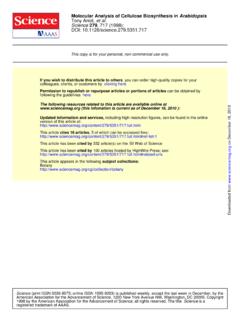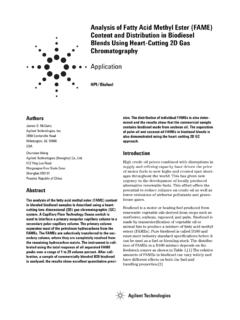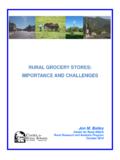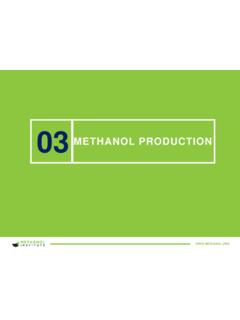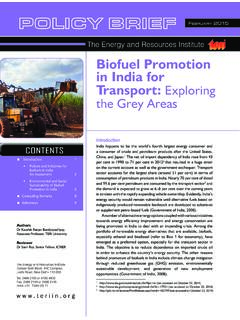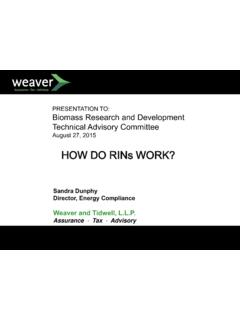Transcription of From organic waste to biodiesel: Black soldier fly ...
1 From organic waste to biodiesel : Black soldier fly, hermetia illucens , makes it feasibleQing Lia,b, Longyu Zhenga, Hao Caia, E. Garzac, Ziniu Yua, , Shengde Zhouc, aState Key Laboratory of Agricultural Microbiology, National Engineering Research Center of Microbial Pesticides, Huazhong Agricultural University, Wuhan 430070, PR ChinabCollege of Science, Huazhong Agricultural University, Wuhan 430070, PR ChinacDepartment of Biological Sciences, Northern Illinois University, DeKalb, IL 60115, USAarticle infoArticle history:Received 29 June 2010 Received in revised form 4 November 2010 Accepted 10 November 2010 Available online 24 November 2010 Keywords:BiodieselBiofuelBlack soldier flyFeedstockOrganic waste managementabstractBiodiesel is a renewable and environmentally friendly liquid fuel. However, the feedstock, predominantlycrop oil, is a limited and expensive food resource which prevents large scale application of of non-food feedstocks are therefore, needed to fully utilize biodiesel s potential.
2 In thisstudy, the larvae of a high fat containing insect, Black soldier fly ( hermetia illucens ) (BSFL), was evaluatedfor biodiesel production. Specifically, the BSFL was grown on organic wastes for 10 days and used forcrude fat extraction by petroleum ether. The extracted crude fat was then converted into biodiesel byacid-catalyzed (1% H2SO4) esterification and alkaline-catalyzed ( NaOH) transesterification, resultingin g, g and g of biodiesel being produced from 1000 BSFL growing on 1 kg of cattle manure,pig manure and chicken manure, respectively. The major ester components of the resulting biodieselwere lauric acid methyl ester ( ), oleinic acid methyl ester ( ) and palmitic acid methyl ester( ). Fuel properties of the BSFL fat-based biodiesel , such as density (885 kg/m3), viscosity( mm2/s), ester content ( ), flash point (123 C), and cetane number (53) were comparable tothose of rapeseed-oil-based biodiesel .
3 These results demonstrated that the organic waste -grown BSFL could be a feasible non-food feedstock for biodiesel production. 2010 Elsevier Ltd. All rights IntroductionSince the last century, fossil fuels have been the major resourcefulfilling energy needs for our economic development. However,concerns of climate change and the decline of non-renewable fossilresources have motivated the development of renewable environ-mentally friendly energy such as, solar energy, wind energy, tidalenergy, and bioenergy from biomass[1,2]. Of those renewableclean energies , liquid biofuels such as bioethanol and biodieselare ready to be produced and can be used directly in existing en-gines used for transportation[3 8].Although biodiesel has the potential to become a primary fuelfor heavy duty trucks and farm tractors, currently, biodiesel is onlyused as a diesel fuel additive to minimize releasing particulates,carbon monoxide, and hydrocarbons[3,4].
4 Production cost is themain obstacle preventing biodiesel from being used as a primaryfuel[9,10]. Cost analysis shows that 75% of biodiesel cost is derivedfrom the feedstock, primarily crop-oil such as soybean oil, rapeseedoil and sunflower oil[11]. In addition to its economic constraints,crop oil is a limited food resource. Using limited food resourcesfor biodiesel production is not a feasible option for developingcountries such as China. To overcome these challenges, non-foodfeedstocks such asJatropha curcas[12], Chinese tallow[13], micro-algae[11,14 16], and others[17]are being developed for biodieselproduction. However, these alternative feedstocks face their ownchallenges, such as, long lifecycle, competing for crop land, andcompeting for limited water the other hand, organic wastes such as animal wastes, resi-dential wastes ( , household), commercial wastes ( , fromstores, markets, shops, hotels, etc.)
5 , and institutional wastes ( ,schools, hospitals, etc.) are generated in large quantities in devel-oping countries. These organic wastes can cause environmentalpollution and become potential health hazards if not managedproperly. In this study, we report the use of organic wastes as a re-source for biodiesel production. Specifically, cattle manure, pigmanure, and chicken manure were evaluated in their ability toraise a high fat containing insect, Black soldier fly (Hermetiaillucens) larvae (BSFL)[18,19], which was then used for biodieselproduction. The fuel properties of the resulting biodiesel werecomparable to those of rapeseed-based biodiesel , and met theEuropean biodiesel standard, Materials and organic wastes, insect species and growth conditionsThe organic wastes (cattle manure, chicken manure and pigmanure) were obtained from the Breeding Farm of Huazhong0016-2361/$ - see front matter 2010 Elsevier Ltd.
6 All rights Corresponding authors. Tel.: +86 27 87280802; fax: +86 27 87393882 (Z. Yu),tel.: +1 815 753 7842; fax: +1 815 753 0461 (S. Zhou).E-mail Zhou).Fuel 90 (2011) 1545 1548 Contents lists available atScienceDirectFueljournal homepage: University, Wuhan, PR China. The insect used in thisstudy, Black soldier fly (H. illucens ) larvae (BSFL), was kindly pro-vided by Dr. Jeffery K. Tomberli from Texas A&M University, Texas,USA. The BSFL had been raised for more than 10 generations atHuazhong Agricultural University before being used in this biomass was produced as follows: BSFL was inoculated intocattle manure, pig manure, and chicken manure at a ratio of1000 larvae per kg of waste , and were incubated for 10 days atroom temperature with 65 70% moisture. The BSFL were then har-vested by sterile forceps, washed by distilled water, inactivated at105 C for 5 min, dried at 60 C for 2 days, and stored at 4 C afterbeing ground with a Extraction of crude fatTo extract crude fat from the BSFL tissue, the grounded BSFL biomass was put into a filter bag and soaked in petroleum etherfor 48 h at room temperature.
7 After the filter bag being removed,the BSFL crude fat contents were then obtained by evaporatingthe petroleum ether using a rotary Production of biodieselBiodiesel production was carried out in a 100 ml reactorequipped with a reflux condenser, a thermometer, a mechanicalstirrer, and a sampling outlet. biodiesel production was accom-plished using a two step process: acid-catalyzed esterification offree fatty acids (FFA) (to decrease the acidity of the crude fat),and alkaline-catalyzed transesterification[20,21]. Acid-catalyzed esterificationThe acid-catalyzed esterification step was a pretreatment usedto convert free fatty acids in the crude fat into biodiesel , and to de-crease the acidity of the crude fat. Specifically, 16 sets of 30 g ofcrude fat were pretreated to esterify the free fatty acid with meth-anol using 1% H2SO4(w/w) as the catalyst at the following condi-tions: four sets were pretreated (methanol to fat ratio 8:1; time1 h) at a temperature of 55 C, 65 C, 75 C, or 85 C, respectively;four sets were pretreated (temperature 75 C, time 1 h) with amethanol to fat ratio of 6:1, 8:1, 10:1, or 12:1, respectively; foursets were pretreated (methanol to fat ratio 8:1, temperature 75 C)with a reaction time of 30 min, 60 min, 90 min, or 120 min, respec-tively.
8 During esterification, 3 ml samples were withdrawn period-ically to determine the free fatty acid conversion. Afterpretreatment, the reaction mixture was poured into a funnel, andwas allowed to separate by gravity. The upper layer (crude fatand biodiesel ) was then transferred to a reactor for alkaline-cata-lyzed Alkaline-catalyzed transesterificationThe upper layer (crude fat and biodiesel ) obtained from theabove acid-catalyzed esterification was mixed with methanol(methanol to fat ratio of 6:1) and the catalyst NaOH ( , w/w).This mixture was placed in a 65 C water bath for 30 min, with agi-tation by a magnetic stirrer. After the reaction, the mixture wasseparated by gravity. The upper biodiesel layer was then separatedfrom the lower layer and purified by distilling at 80 C to removethe residual AnalysisThe fatty acid methyl ester compositions were determined by aGC/MS (Thermo-Finnigan, USA) equipped with a polyethylene gly-col phase capillary column (Agilent, USA).
9 The acid value (AV) ofthe BSFL crude fat was determined by titration with potassiumhydroxide. Free fatty acid (FFA) conversion (%) was calculatedusing the following formula:FFA conversion % AVi AVt =AVi 100:While AVirepresents initial acid value, AVtrepresents the acidvalue at reaction Conversion of organic waste into insect biomassBlack soldier fly larvae (BSFL), is able to grow on organic waste ,a process that converts organic waste into insect biomass. Interest-ingly, 30% of BSFL biomass is composed of fat, which could be avaluable non-food feedstock for biodiesel production, providedthat the organic waste could be converted into insect biomass ata high yield. To test this hypothesis, cattle manure, pig manureand chicken manure were evaluated for efficient production ofBSFL biomass. Specifically, BSFL was inoculated at a ratio of 1000larvae per kg of organic manure, and incubated at 27 C with 60 75% humidity.
10 After 10 days, the organic waste conversion yieldand crude fat content were determined. As shown inTable 1, thethree types of organic wastes were converted into BSFL biomassat varying yield. Chicken manure achieved the highest yield , followed by pig manure at and cattle manure Therefore, chicken manure could be the most valuable re-source used to culture BSFL for biodiesel production, provided thatthe fuel properties of BSFL fat-based biodiesel are comparable tothose of crop oil-based Production of biodieselTen day old BSFL biomass was subjected to petroleum etherextraction, resulting in g, g and g of crude fat forBSFL grown on chicken manure, pig manure and cattle manure,respectively (Table 1). These crude fats, with an acid value of (mg of KOH per g of fats), were used for biodiesel productionby a two step process.
